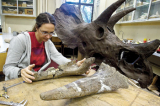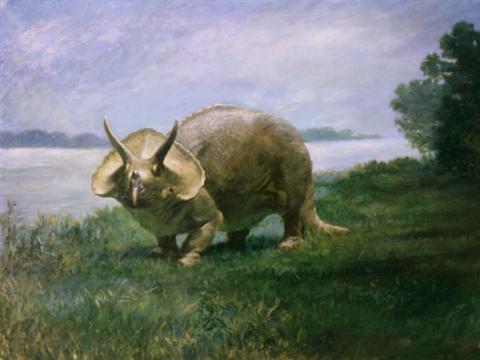 The original Triceratops fossilized skull bones were uncovered during two different excavations: the first in 2006 and the second in 2007. Palaeontologists often prospect for fossils by hiking over exposed rock outcrops many kilometres per day. They have to keep a watchful eye as they look for anything unusual and then do a light surface dig if something catches their attention.
The original Triceratops fossilized skull bones were uncovered during two different excavations: the first in 2006 and the second in 2007. Palaeontologists often prospect for fossils by hiking over exposed rock outcrops many kilometres per day. They have to keep a watchful eye as they look for anything unusual and then do a light surface dig if something catches their attention.
 Once something of significance is found, notes and GPS coordinates are immediately taken so that palaeontologists may return to the site to look for missing pieces or other interesting specimens. As the fossilized dinosaur bones are collected, a quarry map is drawn. Each quadrant represents 1 square metre and they are usually labelled numerically.
Once something of significance is found, notes and GPS coordinates are immediately taken so that palaeontologists may return to the site to look for missing pieces or other interesting specimens. As the fossilized dinosaur bones are collected, a quarry map is drawn. Each quadrant represents 1 square metre and they are usually labelled numerically.

This helps to organize the bones and to provide some sort of guide when later piecing the bones together. After the overlying rock is removed, and the site is significantly documented, the fossilized bones with pick axes and shovels are carefully removed. This process is challenging because the fossilized bones are fragile. As a result, only smaller hand held tools are used, such as brushes and dentist's probes.
Images: By Emily Bamforth. ©Redpath Museum/Musée Redpath.
The Creative Team
 Chantal Montreuil is the palaeontology technician at the Redpath Museum. Chantal began her work on this Triceratops, “Sara,” in 2006. Chantal’s assembly was incredibly painstaking as it took her a total of three years to complete the cranium, entirely by hand, without the use of computers. A fibreglass replica is what stands before viewers today, as the original bones were returned to the Royal Saskatchewan Museum for further study and curation. Initially, this Triceratops cranium was called 516-G, for scientific purposes. So before its public unveiling, it was re-named by Chantal’s son, Keith, who initially introduced his mother to the Redpath Museum. Keith’s favourite childhood movie was The Land Before Time where the Triceratops character is called Cera, and so he gave 516-G a new name: Sara. This Triceratops epitomizes Chantal’s main interests and aims at Redpath Museum: using the history of the natural world to educate and capture the attentive imagination of the public.
Chantal Montreuil is the palaeontology technician at the Redpath Museum. Chantal began her work on this Triceratops, “Sara,” in 2006. Chantal’s assembly was incredibly painstaking as it took her a total of three years to complete the cranium, entirely by hand, without the use of computers. A fibreglass replica is what stands before viewers today, as the original bones were returned to the Royal Saskatchewan Museum for further study and curation. Initially, this Triceratops cranium was called 516-G, for scientific purposes. So before its public unveiling, it was re-named by Chantal’s son, Keith, who initially introduced his mother to the Redpath Museum. Keith’s favourite childhood movie was The Land Before Time where the Triceratops character is called Cera, and so he gave 516-G a new name: Sara. This Triceratops epitomizes Chantal’s main interests and aims at Redpath Museum: using the history of the natural world to educate and capture the attentive imagination of the public.
 Since the time that he was 5 years old, Dr. Hans Larsson was drawn to palaeontology as a career by his intense interest in dinosaurs. After a university education in biology, some geology, a strong interest in interdisciplinary research, and experience in the outdoor fields prepared him for his current job. Hans is now the Canada Research Chair in Macroevolution, and, here at Redpath Museum, he is the vertebrate palaeontologist and an associate professor. He teaches courses such as Animal Diversity, Vertebrate Evolution, Developmental Evolution, and the Vertebrate Palaeontology field course. Hans spearheaded the dig for this Triceratops, “Sara”, along with a group of McGill students taking the 2006 Vertebrate Palaeontology Field course. He recalls that the frill was the first part of “Sara” that was discovered, and it took about 5 days of hard work to remove her skull carefully from the ground. Although her body was never found, Hans and his team also uncovered parts of T.rex, a partial juvenile duckbilled dinosaur, a partial Thescelosaurus (small bipedal herbivore), and parts of crocodiles, turtles, lizards, salamanders, fishes and plants at the same site. His long-term goal for the Redpath Museum and McGill University is to introduce dinosaurs and their contemporaries into the museum in a much larger way so as to foster a stronger public interest in the museum. One of his dreams would be to expand the museum’s public gallery to showcase Canada’s modern and extinct biological diversity and geology. His long-term research goals are to integrate research on the evolution of biodiversity with research on the evolution of the genetic, developmental, and anatomical changes that occurred during evolutionary transitions of the prehistoric past - such as the transitions from fishes to amphibians and from dinosaurs to birds.
Since the time that he was 5 years old, Dr. Hans Larsson was drawn to palaeontology as a career by his intense interest in dinosaurs. After a university education in biology, some geology, a strong interest in interdisciplinary research, and experience in the outdoor fields prepared him for his current job. Hans is now the Canada Research Chair in Macroevolution, and, here at Redpath Museum, he is the vertebrate palaeontologist and an associate professor. He teaches courses such as Animal Diversity, Vertebrate Evolution, Developmental Evolution, and the Vertebrate Palaeontology field course. Hans spearheaded the dig for this Triceratops, “Sara”, along with a group of McGill students taking the 2006 Vertebrate Palaeontology Field course. He recalls that the frill was the first part of “Sara” that was discovered, and it took about 5 days of hard work to remove her skull carefully from the ground. Although her body was never found, Hans and his team also uncovered parts of T.rex, a partial juvenile duckbilled dinosaur, a partial Thescelosaurus (small bipedal herbivore), and parts of crocodiles, turtles, lizards, salamanders, fishes and plants at the same site. His long-term goal for the Redpath Museum and McGill University is to introduce dinosaurs and their contemporaries into the museum in a much larger way so as to foster a stronger public interest in the museum. One of his dreams would be to expand the museum’s public gallery to showcase Canada’s modern and extinct biological diversity and geology. His long-term research goals are to integrate research on the evolution of biodiversity with research on the evolution of the genetic, developmental, and anatomical changes that occurred during evolutionary transitions of the prehistoric past - such as the transitions from fishes to amphibians and from dinosaurs to birds.
 Emily Bamforth completed her PhD at McGill University in 2013. Her experience in excavating “Sara” the Triceratops has played a major contributing factor to her studies here at Redpath Museum. In fact, her thesis focuses on determining climatic drivers of vertebrate palaeobiodiversity in the late Cretaceous (66Ma) of central Canada. Her study sites are situated in southeastern Saskatechewan, located in the badlands of Grasslands National Park and the Frenchman River Valley – an area that includes the site in which “Sara” the Triceratops was found. She believes that the relationships between palaeobiodiversity and palaeoclimate in the same locality yields important insights into the drivers of terrestrial biodiversity leading up the second largest terrestrial mass extinction in earth’s history, thus unlocking some of the mystery behind “Sara”’s death and the disappearance of all large dinosaurs.
Emily Bamforth completed her PhD at McGill University in 2013. Her experience in excavating “Sara” the Triceratops has played a major contributing factor to her studies here at Redpath Museum. In fact, her thesis focuses on determining climatic drivers of vertebrate palaeobiodiversity in the late Cretaceous (66Ma) of central Canada. Her study sites are situated in southeastern Saskatechewan, located in the badlands of Grasslands National Park and the Frenchman River Valley – an area that includes the site in which “Sara” the Triceratops was found. She believes that the relationships between palaeobiodiversity and palaeoclimate in the same locality yields important insights into the drivers of terrestrial biodiversity leading up the second largest terrestrial mass extinction in earth’s history, thus unlocking some of the mystery behind “Sara”’s death and the disappearance of all large dinosaurs.
Images: Chantal Montreuil and Hans Larsson at the Redpath Museum by claudio Calligaris. ©Redpath Museum/Musée Redpath. Emily Bamforth at the Redpath Museum by Owen Egan. ©McGill.
Casts and Moulds – How this Triceratops was made
The Triceratops skull that stands before you is not real. There are no fossilized fragments in this skull. In fact, this Triceratops skull is a fibreglass replica that was cast from the real fossils. There are many reasons why the real fossilized dinosaur bones are not displayed to the public. Large fossils are too heavy to be displayed in this manner once fully assembled. By having the real bones on display, it also makes it harder for palaeontologists to examine the dinosaur bones scientifically. In addition, fossilized dinosaur bones are very fragile and are kept in specific climate controlled conditions.
If fossilized dinosaur bones are left alone and exposed to harsh elements they will be subjected to degradation, as seen by comparing the same bone in the two images below – one from 2010 and one from 2012.


The fossilized bones are preserved for museum display by making moulds and casts. Layers of rubber, silicone, and in some cases latex, are used to create a soft shell mould around the original fossilized bone. Then, in order to create the cast, a gel coat is applied within the soft shell mould as the first step (sometimes the gel is pigmented so that the cast will pick up all the fine details of the mould). The second step is to mix together fibreglass and resin and then pour the mixture into the gel coated mould. Polyurethane (plastic) or dental plaster can also be poured into the mould to create a cast. When the mixture hardens, the cast can be removed from the mould. The third step is to paint the cast so that it resembles the likeness of real fossilized dinosaur bone. Finally, these fibreglass casts are assembled into one coherent display that is presented before you.



